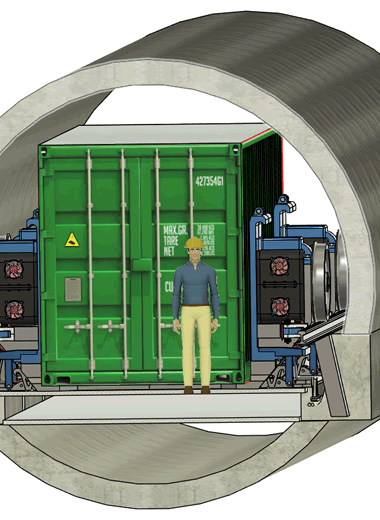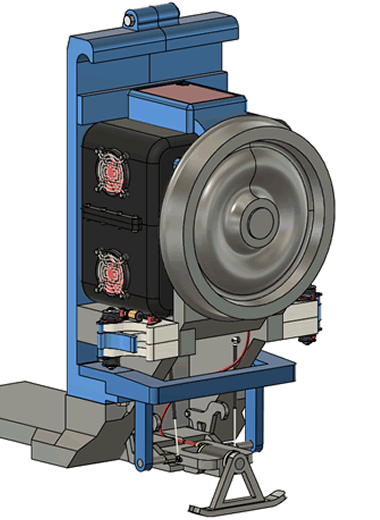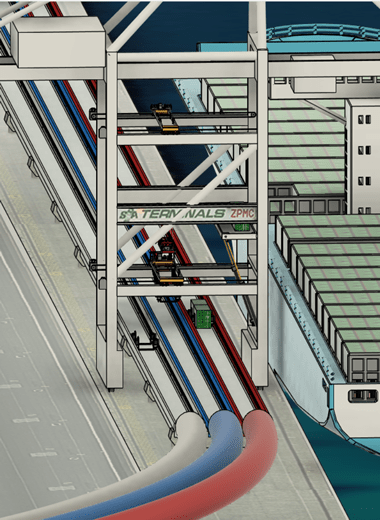Container Freight Technologies
Innovation for Container Freight Distribution
Revolutionary New System for Handling Container Freight
Freight Handling became extremely efficient when the standard for intermodal freight containers was defined and quickly adopted around the world. Huge investment was made in land-based infrastructure to support both standard container sizes. Many refinements have occurred over the years to improve efficiency and throughput. At many installations, the intermodal hub is located at the port and has often been a major source of congestion. While ship-to-shore transfer is fast and efficient, distribution from port to importer is often hampered by congestion. Port areas have become centres for population growth, and conflicts arise between passenger rail and freight rail. Also, trucks compete with private vehicles for roads surrounding the ports, and this results in an additional undesirable impact on the environment.
At CF Technologies, we took a clean-canvas approach for container-freight handling to determine the best way to serve the needs of both the shipping industry and the surrounding communities. After several years of creative work we are focused on a robot enabled technology where sets of powered-wheels are attached to each container so they become vehicles that can be centrally controlled. These container-vehicles travel in pipes that can be routed underground, at ground level, or elevated above ground.
Logistics Innovation
The introduction of encased, semi-autonomous container-vehicles allows for continuous delivery, thus removing the need for container “accumulation areas”. Containers can be moved in single batches to one destination (ship loading), or in segregated batches to several loading points. Scheduling can coordinate delivery with the ship speed and loading capacity to provide a “just-in-time” solution.
- Faster ship turn-around – no enforced delays introduced by land based scheduling or capacity conflicts
- Greater value to freight for exporters – cost saving due to efficiencies in delivery, the utilisation of the capital infrastructure and minimum additional storage requirement en route
- Smooth Flow of containers to and from ships is a key requirement for optimum efficiency
Strategic Fit
The primary objectives are not to interrupt, impede or spoil the current lay-of-the-land, and to avoid accumulation points between ports and hubs. The pipe structure provides the most efficient container-transfer for all configurations – surface rail, and installations above or below ground.
- Minimal Handling — The system provides cost savings in terms of capital equipment and expenditure on labour. By removing excess double handling and unnecessary lay-down points between the hub and the port, optimal delivery times can be achieved. In addition, reducing the number of process points on the delivery path removes many of the “opportunities to fail”.
- Quality Management — Constant monitoring of each separate process is important in identifying the leading-indicators of non-conformance. Quickly isolating the root cause helps determine the most appropriate corrective action. The design permits rapid human intervention to ensure an effective recovery in the event of any non-conformance.
- Delivery Scheduling — Transfers between port and hub will be scheduled to maximise asset utilisation, and also optimise the efficiency of delivery.
- Innovative Evolution — CF Technologies is developing a culture of continuous learning. Conformance to both Quality and Scheduling specifications, will identify opportunities for improvement via strict statistical analysis.
Broader Community Benefits
Integration of the CF Technologies System at a port and associated remote logistics hubs, will create the following benefits…
- Employment opportunities in areas surrounding remote hubs, and advantages of living closer to the place of work
- Efficiencies in scheduling, receiving, batching, and container handling
- Elimination of rail and road congestion – improved ability to utilise existing roads and rail for passenger traffic since much of the freight requirement will no longer require that infrastructure
- Reduction of the associated noise, pollution, road crossing maintenance, and rail scheduling conflicts
- Remove the necessity for the port land requirement to expand as export and import volumes increase
Environmental Benefits
CF Technologies has clearly demonstrable benefits in the following areas…
- Noise and vibration — almost complete absence
- Good Air-Quality and low greenhouse-gas emissions
- Landscape and visual amenity — structure can be easily hidden or disguised
- Best use of Land and Property — facilitated by off-site intermodal hub and storage
- Reduced congestion on the Roads and in Rail
- Social impacts on domestic development in the vicinity
- Transport economics and best utilisation of capital enables users to control their own off-site facility, thereby relocating activities from congested Port areas
- Single Entry/Exit point to facilitate customs and biosecurity checks
Core Technologies

The container vehicles can be completely encased in a tube or pipe. There are several advantages related to this. At ground level, a system encased in a pipe has a relatively small footprint because the separation strip between the rail and its surroundings can be reduced to a minimum.
Noise is also minimised. As with all electrified rail systems, pollution levels are almost non-existent, at least at the point of delivery. In addition, the pipe design is well suited to tunnels whenever the track needs to be routed underground.

The basic concept is to transform containers into vehicles by temporarily attaching motors and wheels. The engineering challenges have been substantial, but we have refined the design to produce a practical and cost effective solution.
A critical design requirement was to supply power to the DDUs. The third-rail option was chosen where shoes extend from the units and make contact with power lines half buried at both sides of the pipe.

The system depends upon an efficient mechanism to assemble the containers and the DDUs together to form Container Vehicles. Key to the success of CFT is a modification that can be made to any standard ship-to-shore crane. In addition to the main gantry which moves the containers with a Spreader, there are two secondary gantries.
These secondary gantries unite the containers with DDUs so they can be placed on the pipe-rail. They also split container-handling into two stages which should reduce ship load or unload times by around 20 percent.
